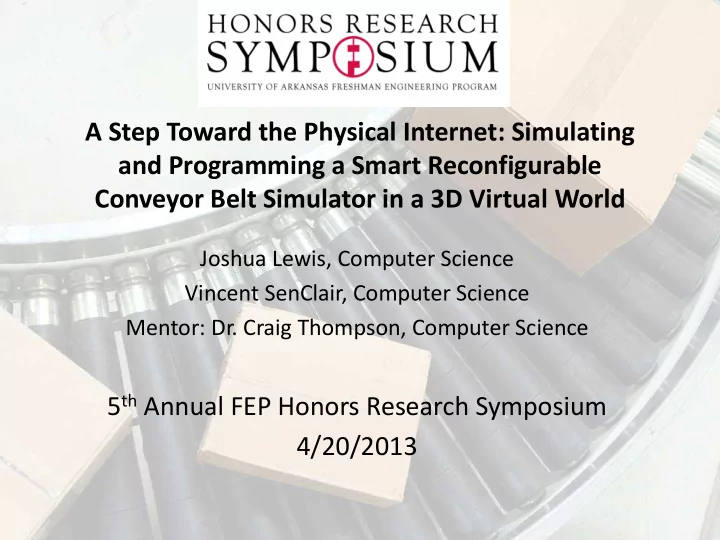

A Step Toward the Physical Internet: Simulating and Programming a Smart Reconfigurable Conveyor Belt Simulator in a 3D Virtual World Joshua Lewis, Computer Science Vincent SenClair, Computer Science Mentor: Dr. Craig Thompson, Computer Science 5 th Annual FEP Honors Research Symposium 4/20/2013
Problem • Currently, conveyor belt systems are custom made for each customer – This method is expensive and time consuming. – It also limits the reconfigurability of the system, limiting expansion • If conveyor belts can be made more standardized and “smarter,” then they will be able to easily integrate with other transport systems • This is a step toward a “Physical Internet” Lewis and SenClair 5th Annual FEP Honors Research Symposium 2
Objective • To use a virtual world to simulate a reconfigurable conveyor belt system • This includes standardized parts, a unified programming language, and an easy Basic building block, including menus for adjustment system to configure the parts 5th Annual FEP Honors Research Lewis and SenClair 3 Symposium
Background: Pervasive Computing • Connect everything with computers. Every object can “talk” to every other object • On a smaller scale, every piece of a conveyor system to “talk” to every other piece and other systems • Everything is Alive – Link real world to virtual worlds Lewis and SenClair 5th Annual FEP Honors Research Symposium 4
Background: Virtual Worlds • Can be used to simulate the real world • Much cheaper than building test models • Offer more redesign capability than test models Lewis and SenClair 5th Annual FEP Honors Research Symposium 5
Background: RFID • RFID tags can be used to read what is in a package and find information on it • Passive RFID tags can be used to control the flow of packages in conveyor systems Lewis and SenClair 5th Annual FEP Honors Research Symposium 6
Background: U. of Karlsruhe • A team at the University of Karlsruhe in Germany has designed the Flexconveyor, a reconfigurable conveyor system that uses RFID Lewis and SenClair 5th Annual FEP Honors Research Symposium 7
Objectives 1. Create the individual parts of a conveyor belt system 2. Design a method of controlling the parts and how they interact 3. Put the pieces together to create an easy, reconfigurable conveyor belt system Lewis and SenClair 5th Annual FEP Honors Research Symposium 8
Object Pieces Created several virtual conveyor belt building blocks including: • Basic transport pieces • Shunter segments • Delaying segments • Sensor “tower” to detect stats of objects Basic transport pieces showing color-coded directions 5th Annual FEP Honors Research Lewis and SenClair 9 Symposium
Using Sensor Functions to Determine Paths • Sensor functions allow objects within a certain radius to be detected • Positions, orientations, and purposes of pieces can be determined • This data can be fed into third-party systems to help build a path for materials • Similar to RFID technology 5th Annual FEP Honors Research 12/15/2015 10 Symposium
Virtual Waypoint System Current design allows for a waypoint system to • Detect configuration of conveyor belt system • Accept coordinate values and orientations of pieces as data • Guide a virtual box or package along the conveyor belt 5th Annual FEP Honors Research 12/15/2015 11 Symposium
Conclusions • Current system offers a glimpse into the possibilities of “smart” conveyor belts • The virtual aspect provides a cheap, efficient building block for future projects 5th Annual FEP Honors Research 12/15/2015 12 Symposium
Future Work • Future projects can use this system as a stepping stone to build more complex conveyor belts • “Smarter” systems can be made using robotics to aid in simulating a real-world conveyor belt 5th Annual FEP Honors Research 12/15/2015 13 Symposium
References • “Shared Transportation System Would Increase Profits, Reduce Carbon Emissions, Study Finds,“ (2012) University of Arkansas Newswire, October 16, 2012, see http://newswire.uark.edu/article.aspx?id=19422 • Saha , D. and A. Mukherjee (2003). “Pervasive Computing: A Paradigm for the 21 st Century,” IEEE Computer Society . • Becker, M., P. Salvatore, F. Zirpoli (2005). “The impact of virtual simulation tools on problem- solving and new product development organization,” Research Policy , Vol. 34, Issue 9, pp 1305-1321. • Thompson, C. (2004). “Everything is Alive,” IEEE Internet Computing. • Want, R. (2006). “An Introduction to RFID Technology,” IEEE CS and IEEE ComSoc. • Mayer, S. (2009). Development of a completely decentralized control system for modular continuous conveyors , Ph.D. thesis at the University of Karlsruhe. Lewis and SenClair 5th Annual FEP Honors Research Symposium 14
Recommend
More recommend